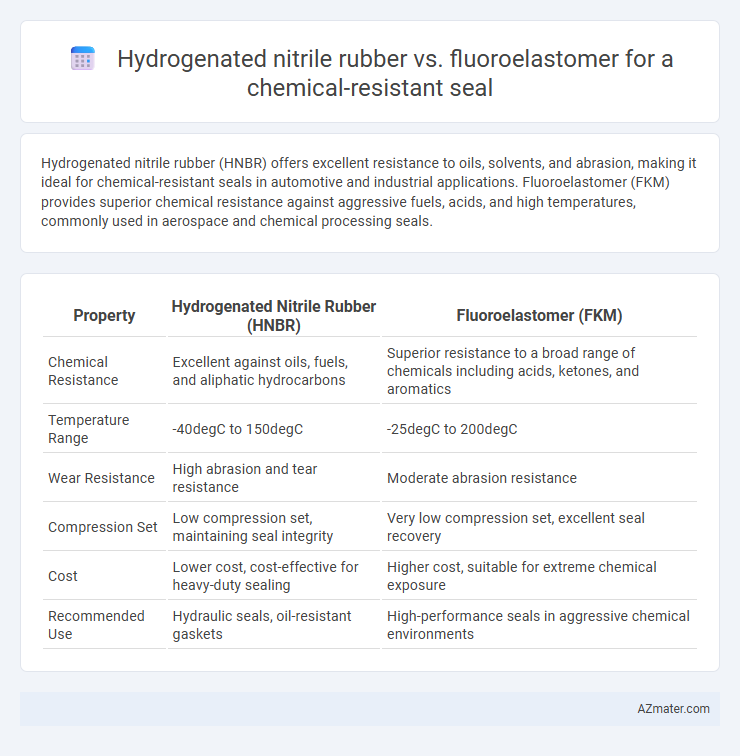Hydrogenated nitrile rubber (HNBR) offers excellent resistance to oils, solvents, and abrasion, making it ideal for chemical-resistant seals in automotive and industrial applications. Fluoroelastomer (FKM) provides superior chemical resistance against aggressive fuels, acids, and high temperatures, commonly used in aerospace and chemical processing seals.
Table of Comparison
| Property | Hydrogenated Nitrile Rubber (HNBR) | Fluoroelastomer (FKM) |
|---|---|---|
| Chemical Resistance | Excellent against oils, fuels, and aliphatic hydrocarbons | Superior resistance to a broad range of chemicals including acids, ketones, and aromatics |
| Temperature Range | -40degC to 150degC | -25degC to 200degC |
| Wear Resistance | High abrasion and tear resistance | Moderate abrasion resistance |
| Compression Set | Low compression set, maintaining seal integrity | Very low compression set, excellent seal recovery |
| Cost | Lower cost, cost-effective for heavy-duty sealing | Higher cost, suitable for extreme chemical exposure |
| Recommended Use | Hydraulic seals, oil-resistant gaskets | High-performance seals in aggressive chemical environments |
Introduction to Chemical-Resistant Seal Materials
Hydrogenated nitrile rubber (HNBR) and fluoroelastomer (FKM) are essential chemical-resistant seal materials used in demanding industrial applications. HNBR offers excellent resistance to oils, fuels, and heat, making it suitable for seals exposed to harsh petroleum-based fluids. FKM provides superior chemical resistance to a wide range of aggressive chemicals, including acids, solvents, and high-temperature environments, ensuring reliable sealing performance in extreme conditions.
Overview of Hydrogenated Nitrile Rubber (HNBR)
Hydrogenated Nitrile Rubber (HNBR) is a highly durable synthetic elastomer known for its excellent resistance to heat, chemicals, and mechanical wear, making it ideal for chemical-resistant seals in demanding industrial applications. Its saturated polymer backbone provides superior resistance to oxidative and ozone degradation compared to traditional nitrile rubber, enhancing seal longevity in aggressive environments. HNBR performs well in temperatures ranging from -40degC to 150degC and offers outstanding resistance to oils, fuels, and many chemicals, making it a versatile choice for sealing solutions where chemical compatibility and durability are critical.
Overview of Fluoroelastomer (FKM)
Fluoroelastomer (FKM) offers superior chemical resistance compared to hydrogenated nitrile rubber, excelling in environments with exposure to fuels, oils, and aggressive chemicals. FKM seals maintain flexibility and durability at high temperatures up to 200degC, making them ideal for demanding industrial applications. Their resistance to ozone, weathering, and a wide range of solvents ensures long-lasting performance in harsh chemical sealing environments.
Key Chemical Resistance Properties
Hydrogenated nitrile rubber (HNBR) offers superior resistance to oils, fuels, and aliphatic hydrocarbons, making it ideal for seals exposed to petroleum-based chemicals and high abrasion environments. Fluoroelastomer (FKM) excels in resisting a broader range of aggressive chemicals including aromatic hydrocarbons, ketones, and chlorinated solvents, with outstanding performance at elevated temperatures up to 250degC. While HNBR provides excellent tensile strength and resistance to hydrogen sulfide and ozone, FKM's chemical resistance profile is more robust for high-temperature and harsh chemical applications in aerospace and chemical processing industries.
Temperature Performance Comparison
Hydrogenated nitrile rubber (HNBR) maintains flexibility and chemical resistance in temperatures ranging from -40degC to 150degC, making it suitable for moderate thermal environments. Fluoroelastomers (FKM), however, exhibit superior temperature resistance, with operational ranges typically from -20degC up to 250degC, ensuring stability in high-heat applications. The enhanced thermal performance of FKM seals makes them ideal for aggressive chemical exposure and high-temperature sealing tasks compared to HNBR.
Mechanical and Physical Strength
Hydrogenated nitrile rubber (HNBR) offers superior tensile strength and abrasion resistance, making it ideal for dynamic sealing applications exposed to harsh chemicals and extreme temperatures. Fluoroelastomers (FKM) provide exceptional chemical resistance and thermal stability but generally exhibit lower tensile strength and elongation compared to HNBR. For mechanical and physical strength in chemical-resistant seals, HNBR is preferred where durability and wear resistance are critical, while FKM excels in static sealing with superior resistance to aggressive fluids.
Compatibility with Aggressive Chemicals
Hydrogenated nitrile rubber (HNBR) demonstrates excellent compatibility with oils, fuels, and moderately aggressive chemicals, making it ideal for sealing applications exposed to hydrocarbons and alkaline substances. Fluoroelastomers (FKM) offer superior resistance to a broader range of aggressive chemicals, including strong acids, ketones, and high-temperature oxidizing environments, outperforming HNBR in chemical inertness. Selecting between HNBR and FKM depends on the specific chemical exposure, with FKM favored for extreme chemical resistance and high-temperature applications while HNBR provides cost-effective durability in less aggressive chemical conditions.
Cost and Availability Factors
Hydrogenated nitrile rubber (HNBR) offers a cost-effective solution for chemical-resistant seals with higher availability due to widespread production and raw material sources. Fluoroelastomers (FKM) provide superior chemical resistance and thermal stability but come at a significantly higher price, often limiting their use to specialized applications. Supply chain stability and manufacturing scale also favor HNBR, making it a preferred choice when balancing performance with cost and availability constraints.
Application Suitability and Industry Use
Hydrogenated nitrile rubber (HNBR) exhibits excellent resistance to oils, fuels, and chemicals, making it ideal for automotive, oil and gas, and industrial sealing applications requiring high abrasion and heat resistance. Fluoroelastomers (FKM) offer superior chemical resistance to acids, solvents, and high-temperature environments, suiting aerospace, pharmaceutical, and chemical processing industries where durability against aggressive chemicals is critical. The choice between HNBR and FKM depends on specific chemical exposure, temperature range, and mechanical demands in sealing applications.
Summary: Choosing the Right Material for Chemical-Resistant Seals
Hydrogenated nitrile rubber (HNBR) offers excellent resistance to oils, fuels, and aliphatic hydrocarbons, making it ideal for seals exposed to automotive and industrial fluids. Fluoroelastomer (FKM) demonstrates superior resistance to a broader range of chemicals, including acids, fuels, and high-temperature environments, suitable for extreme chemical exposure and heat resistance. Selecting between HNBR and FKM depends on specific chemical compatibility, temperature requirements, and the operational environment to ensure optimal seal performance and longevity.

Infographic: Hydrogenated nitrile rubber vs Fluoroelastomer for Chemical-resistant seal
 azmater.com
azmater.com